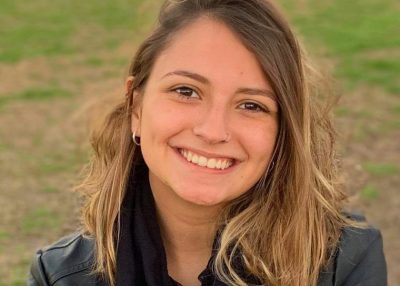Undergraduate Images Gold to Win “Gold”
December 9, 2020
 It is not often that an undergraduate takes top prize at an academic conference’s Student Showcase. But that is exactly what Marília Ferraz da Costa, a Brazilian student who spent a semester analyzing gold-bearing samples with techniques developed at the Jackson School of Geosciences, accomplished.
It is not often that an undergraduate takes top prize at an academic conference’s Student Showcase. But that is exactly what Marília Ferraz da Costa, a Brazilian student who spent a semester analyzing gold-bearing samples with techniques developed at the Jackson School of Geosciences, accomplished.
This November, she received first place for her virtual presentation to a Society of Economic Geologists panel.
“The cool part is that Marília was up against 30 M.S. and Ph.D. students,” said Rich Ketcham, professor in the Department of Geological Sciences (DGS) and one of her project’s faculty supervisors. “The judges didn’t realize she was only an undergraduate until they’d already determined she was the best!”
Ferraz da Costa’s research examined the occurrence of gold—from grain size and shape to orientation—in samples from Brazil’s Cuiabá deposit. This information will help optimize ore processing as well as the discovery of new deposits. The project was arranged by her mentors Lydia Lobato, a professor in the Departamento de Geologia at the Federal University of Minas Gerais, and J. Richard Kyle, a professor in the DGS.
Arriving in Austin in January, 2019, Ferraz da Costa signed up for Ketcham’s graduate class on 3-D data processing and began collecting data in the CT lab. She analyzed several samples with different mineralization types using CT and digital radiography, and documented thousands of grains of gold by shape, size and orientation. It is the 3D in situ technique developed by Ketcham and Kyle that make this research cutting-edge, allowing every gold grain in a sample to be found and studied with respect to other minerals and regional structures which provides new clues on how mineralization occurred. The more typical analyses of ore are done using thin sections, or in two dimensions, which can be a challenge given the fine grain size and low gold abundance even in high grade ore.
“Marília is a highly focussed and industrious student, who took full advantage of the opportunity to work with the outstanding researchers of the JSG CT lab,” said Kyle. To extend her North American experience beyond the lab, Ferraz da Costa also took Kyle’s class on regional studies in mineral resources geology, which included tours of large copper mines in New Mexico and critical mineral resources in west Texas. “Marília continued to work on the project after she returned to Brazil, and we are delighted that the judges watching her presentation recognized the unprecedented data set she had generated and interpreted.”
Stay tuned: the presentation, Orogenic gold in three-dimensions: A case study of distinct mineralization styles at the world-class Cuiabá deposit, Brazil using high-resolution X-ray computed tomography, is currently being prepared for publication in a peer-reviewed journal.
Written by Kristin Phillips, Department of Geological Sciences